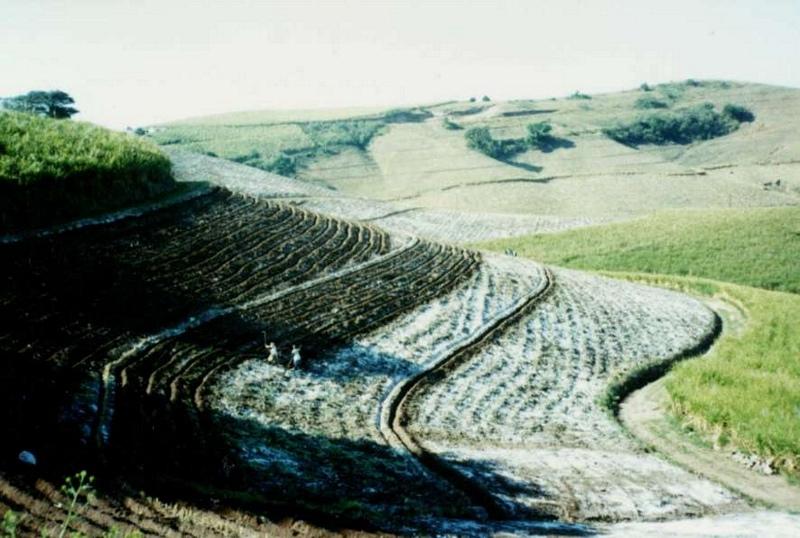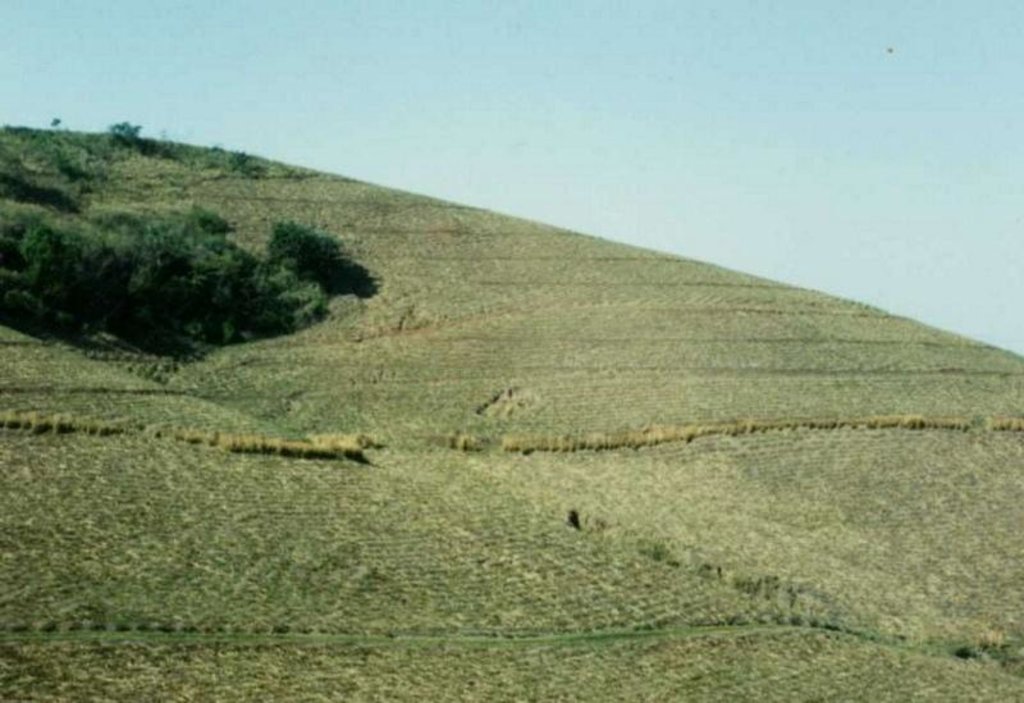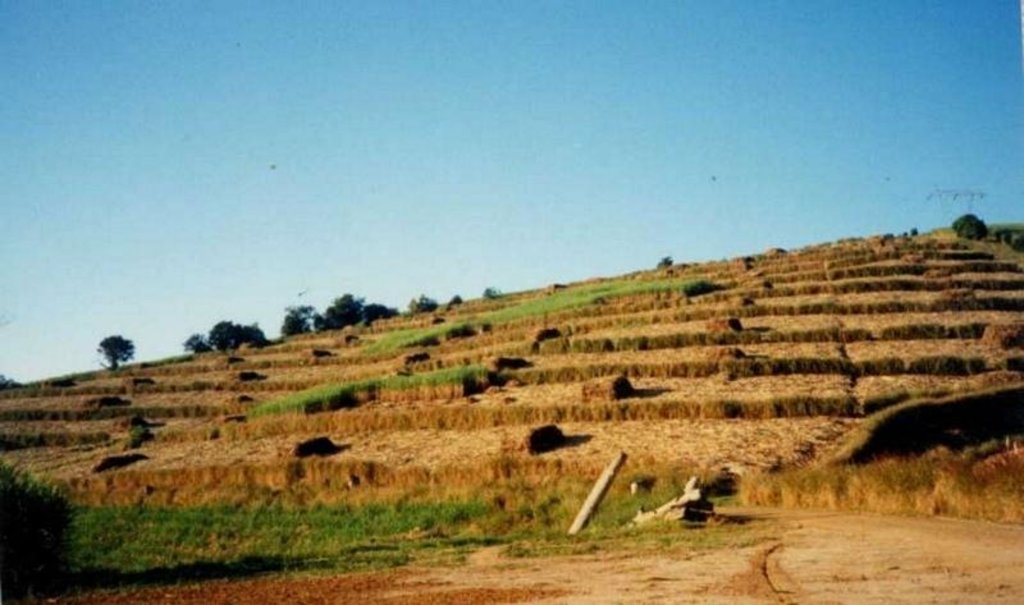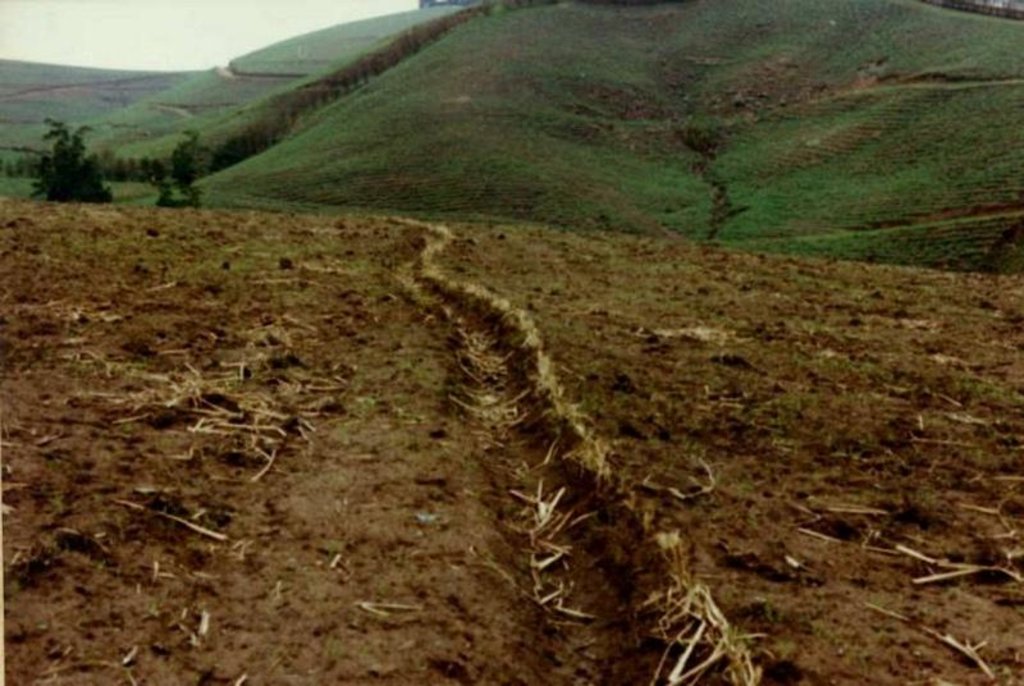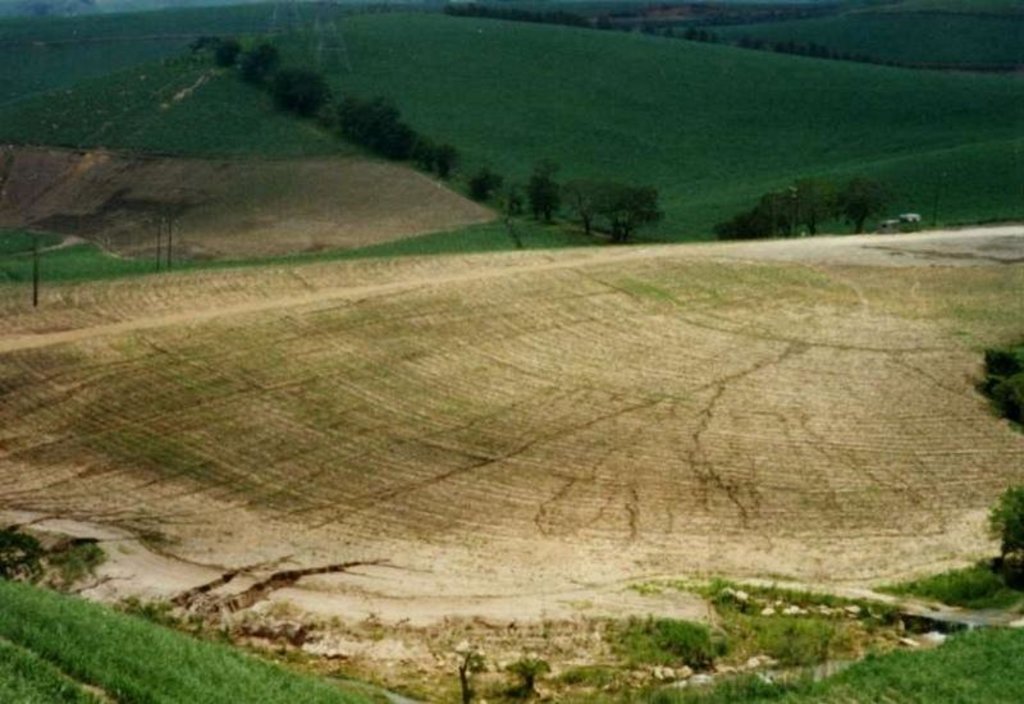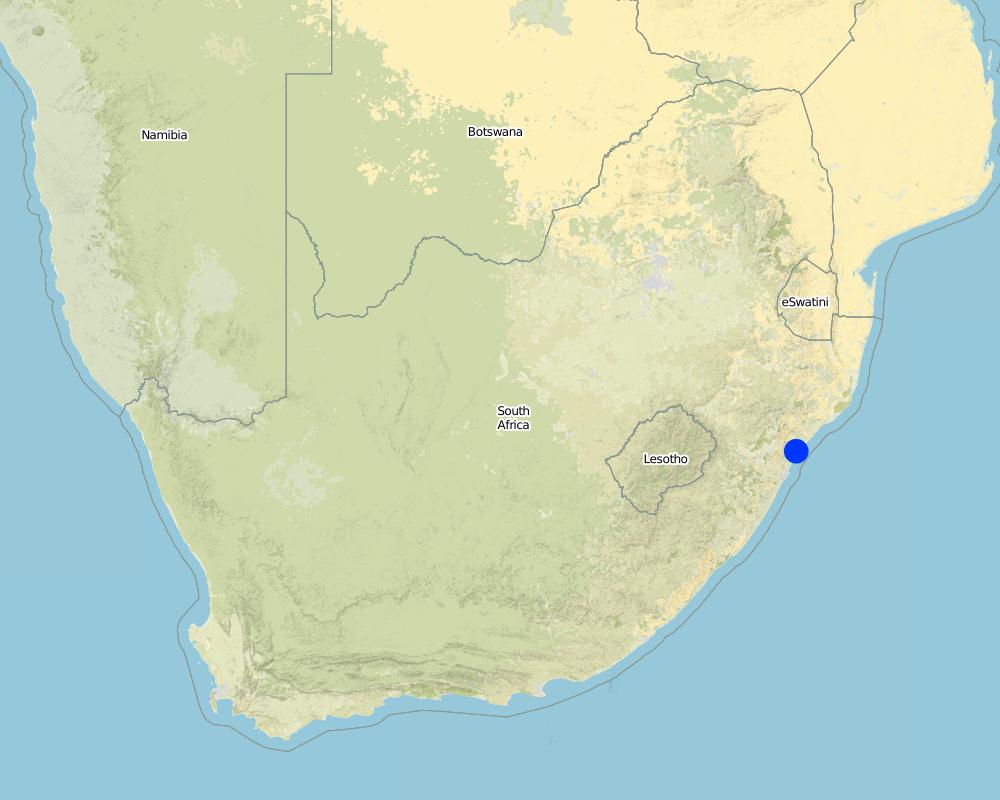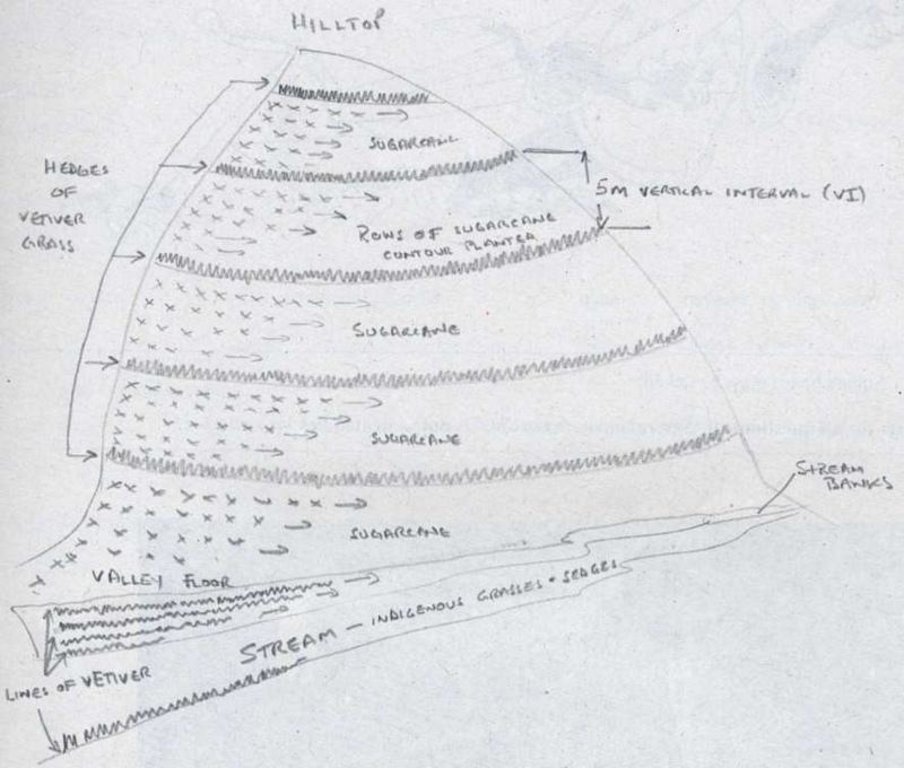Vetiver grass soil conservation system [แอฟริกาใต้]
- ผู้สร้างสรรค์:
- การอัพเดท:
- ผู้รวบรวม: Unknown User
- ผู้เรียบเรียง: –
- ผู้ตรวจสอบ: David Streiff, Alexandra Gavilano, Deborah Niggli
Vetiver system
technologies_938 - แอฟริกาใต้
ดูส่วนย่อย
ขยายทั้งหมด ย่อทั้งหมด1. ข้อมูลทั่วไป
1.2 รายละเอียดที่ติดต่อได้ของผู้รวบรวมและองค์กรที่เกี่ยวข้องในการประเมินและการจัดเตรียมทำเอกสารของเทคโนโลยี
วิทยากรหลัก
ผู้ใช้ที่ดิน:
Stranic Rowan
South African Sugar Association
แอฟริกาใต้
ผู้เชี่ยวชาญ SLM:
Grimshaw Dick
The Vetiver Network
สหรัฐอเมริกา
ชื่อของโครงการซึ่งอำนวยความสะดวกในการทำเอกสารหรือการประเมินเทคโนโลยี (ถ้าเกี่ยวข้อง)
Book project: where the land is greener - Case Studies and Analysis of Soil and Water Conservation Initiatives Worldwide (where the land is greener)ชื่อขององค์กรซึ่งอำนวยความสะดวกในการทำเอกสารหรือการประเมินเทคโนโลยี (ถ้าเกี่ยวข้อง)
The Vetiver Network International (TVNI) - สหรัฐอเมริกาชื่อขององค์กรซึ่งอำนวยความสะดวกในการทำเอกสารหรือการประเมินเทคโนโลยี (ถ้าเกี่ยวข้อง)
South African Sugar Association (SASA) - แอฟริกาใต้1.3 เงื่อนไขการใช้ข้อมูลที่ได้บันทึกผ่านทาง WOCAT
ผู้รวบรวมและวิทยากรหลักยอมรับเงื่อนไขเกี่ยวกับการใช้ข้อมูลที่ถูกบันทึกผ่านทาง WOCAT:
ใช่
1.5 Reference to Questionnaire(s) on SLM Approaches (documented using WOCAT)
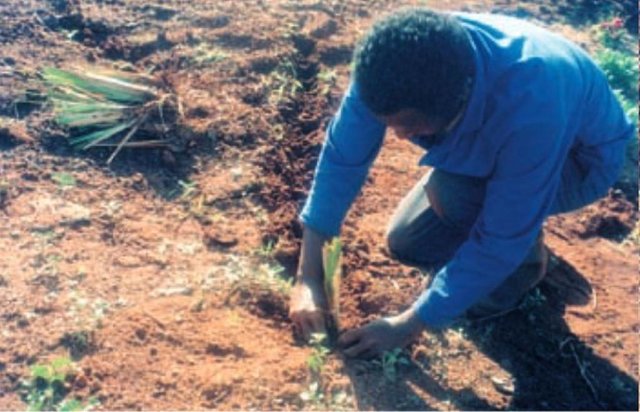
Self teaching [แอฟริกาใต้]
Learning how to use vetiver grass as a vegetative conservation barrier through instructions from a booklet and hands-on practical experience.
- ผู้รวบรวม: Philippe Zahner
2. การอธิบายลักษณะของเทคโนโลยี SLM
2.1 การอธิบายแบบสั้น ๆ ของเทคโนโลยี
คำจำกัดความของเทคโนโลยี:
Contour lines of vetiver grass planted within fields of sugar cane, on stream banks and roadsides, to act as ‘hedges against erosion’.
2.2 การอธิบายแบบละเอียดของเทคโนโลยี
คำอธิบาย:
This example of vetiver grass barriers comes from a commercial farm in Kwa-Zulu Natal, South Africa, where sugar cane is grown on a large scale under a rainfall regime of around 1,000 mm per year. Vetiver grass (Vetiveria zizanioides), which had been growing naturally on the farm for years in isolated clumps, began to be used in 1989 to form vegetative hedges along the contour.
The purpose of these hedges is to protect the land from surface erosion by creating semi-permeable barriers, allowing excess runoff to filter through but holding back sediment. Infiltration is thus increased and moisture conserved in-situ. Although sugar cane in itself protects the soil quite well when the canopy is closed, after harvest on the moderate to steep slopes (10% to >30%) and erodible soils of the north coast of Kwa-Zulu Natal, extra protection is required. The vetiver system is supplemented by other soil conservation measures such as strip cropping, terraces, mulching and minimum tillage – all of which are used to some extent on this farm. Vetiver also helps by permanently marking the contour line, which then guides land preparation. In common with other vegetative barriers, vetiver lines lead to the formation of terraces over time, through the effect of tillage and water erosion between the strips.
Vetiver clumps are dug up and separated into slips (tillers), cut to a length of 10 cm and then planted 10–15 cm apart along the contour, also by stream banks, and by roadsides, just before the rains. This ensures good establishment. Single lines are used in this farm, though double lines are more effective at creating a hedge, and are the normal recommendation. Work starts at the top of the slope, and continues downwards. The cross-slope grass hedges are sited at 5 m vertical intervals on slopes of more than 10%, in lines about 200 m long. The cost of vetiver grass planting depends very much on slope (and thus the number of lines to be planted), availability of materials and labour.
Maintenance is very important, as vetiver often requires ‘gapping-up’ to keep the barrier dense, and it needs also to be cut back before the dry season to prevent it burning. The cut material can be used for mulching. Vetiver is poorly palatable, and therefore not useful as fodder. The maximum height of a vetiver hedge is kept down to approximately 50 cm. This minimises shading and competition, keeps the fire risk low, increases tillering (for production of vegetative splits) and ensures adequate density.
2.3 รูปภาพของเทคโนโลยี
2.5 ประเทศภูมิภาค หรือสถานที่ตั้งที่เทคโนโลยีได้นำไปใช้และได้รับการครอบคลุมโดยการประเมินนี้
ประเทศ:
แอฟริกาใต้
ภูมิภาค/รัฐ/จังหวัด:
KwaZulu/Natal
ข้อมูลจำเพาะเพิ่มเติมของสถานที่ตั้ง :
Lower Tugela district
ระบุการกระจายตัวของเทคโนโลยี:
- กระจายไปอย่างสม่ำเสมอในพื้นที่
If the Technology is evenly spread over an area, specify area covered (in km2):
8.0
If precise area is not known, indicate approximate area covered:
- 1-10 ตร.กม.
แสดงความคิดเห็น:
Total area covered by the SLM Technology is 8 km2.
The vetiver system has been applied on my own properties. Neighbouring farms have adopted other methods of conserving the soil. i.e. vegetative, agronomic and structural in various combinations (= farm)
Map
×2.6 วันที่การดำเนินการ
ถ้าไม่รู้ปีที่แน่นอน ให้ระบุวันที่โดยประมาณ:
- น้อยกว่า 10 ปี (ไม่นานนี้)
2.7 คำแนะนำของเทคโนโลยี
ให้ระบุว่าเทคโนโลยีถูกแนะนำเข้ามาอย่างไร:
- ในช่วงการทดลองหรือการทำวิจัย
ความคิดเห็น (ประเภทของโครงการ เป็นต้น) :
The grass originally came to this country from Mauritius.
3. การจัดประเภทของเทคโนโลยี SLM
3.1 วัตถุประสงค์หลักของเทคโนโลยี
- ลด ป้องกัน ฟื้นฟู การเสื่อมโทรมของที่ดิน
3.2 ประเภทของการใช้ที่ดินในปัจจุบันที่ได้นำเทคโนโลยีไปใช้

พื้นที่ปลูกพืช
- การปลูกพืชยืนต้นที่ไม่มีเนื้อไม้
Perennial (non-woody) cropping - Specify crops:
- sugar cane
จำนวนของฤดูเพาะปลูกต่อปี:
- 1
ระบุ:
Longest growing period in days: 200; Longest growing period from month to month: Oct - April
แสดงความคิดเห็น:
Major cash crop: sugar cane
Major land use problems (compiler’s opinion): The steep topography and shallow soils limit the types of land use possible e.g.. perennial grass cover (sugarcane or grazing) or commercial timber production. Annual cropping is not possible without major alteration to the landscape e.g. terracing.
3.4 การใช้น้ำ
การใช้น้ำของที่ดินที่มีการใช้เทคโนโลยีอยู่:
- จากน้ำฝน
3.5 กลุ่ม SLM ที่ตรงกับเทคโนโลยีนี้
- การปรับปรุงดิน / พืชคลุมดิน
- มาตรการปลูกพืชขวางความลาดชัน (cross-slope measure)
3.6 มาตรการ SLM ที่ประกอบกันเป็นเทคโนโลยี

มาตรการอนุรักษ์ด้วยวิธีพืช
- V5: อื่นๆ
แสดงความคิดเห็น:
Main measures: vegetative measures
Secondary measures: agronomic measures, structural measures, management measures
Specification of other vegetative measures: grass strip as hedges
Type of agronomic measures: mulching, minimum tillage, contour ridging
3.7 รูปแบบหลักของการเสื่อมโทรมของที่ดินที่ได้รับการแก้ไขโดยเทคโนโลยี

การกัดกร่อนของดินโดยน้ำ
- Wt (Loss of topsoil): การสูญเสียดินชั้นบนหรือการกัดกร่อนที่ผิวดิน
- Wg (Gully erosion): การกัดกร่อนแบบร่องธารหรือการทำให้เกิดร่องน้ำเซาะ

การกัดกร่อนของดินโดยลม
- Et (Loss of topsoil): การสูญเสียดินชั้นบน

การเสื่อมโทรมของน้ำ
- Hg (Change in groundwater): การเปลี่ยนแปลงของน้ำบาดาลหรือระดับน้ำในแอ่งน้ำบาดาล
3.8 การป้องกัน การลดลง หรือการฟื้นฟูความเสื่อมโทรมของที่ดิน
ระบุเป้าหมายของเทคโนโลยีกับความเสื่อมโทรมของที่ดิน:
- ลดความเสื่อมโทรมของดิน
- ฟื้นฟูบำบัดที่ดินที่เสื่อมโทรมลงอย่างมาก
แสดงความคิดเห็น:
Secondary goals: rehabilitation / reclamation of denuded land
4. ข้อมูลจำเพาะด้านเทคนิค กิจกรรมการนำไปปฏิบัติใช้ ปัจจัยนำเข้า และค่าใช้จ่าย
4.1 แบบแปลนทางเทคนิคของเทคโนโลยี
ข้อมูลจำเพาะด้านเทคนิค (แบบแปลนทางเทคนิคของเทคโนโลยี):
Vetiver grass is planted as a vegetative barrier (hedge), on the contour at 5 metre vertical intervals within fields of sugarcane.
Location: Lower Tugela district. KwaZulu/Natal
Technical knowledge required for field staff / advisors: low
Technical knowledge required for land users: low
Main technical functions: control of dispersed runoff: impede / retard
Secondary technical functions: control of concentrated runoff: impede / retard, increase / maintain water stored in soil
Mulching
Material/ species: Sugarcane
Remarks: Full ground cover
Minimum tillage
Material/ species: Chemical crop eradication
Contour ridging
Material/ species: Planting lines ridged on contour
Vegetative measure: contour
Vegetative material: G : grass
Vertical interval between rows / strips / blocks (m): 5
Spacing between rows / strips / blocks (m): 2
Vertical interval within rows / strips / blocks (m): 0
Width within rows / strips / blocks (m): 0.5
Vegetative measure: Vegetative material: G : grass
Grass species: Vetiver grass
Slope (which determines the spacing indicated above): 20.00%
If the original slope has changed as a result of the Technology, the slope today is (see figure below): 20.00%
Gradient along the rows / strips: 0.00%
Other type of management: Cane is planted on suitability (slope, soil depth)
ผู้เขียน:
Marie Joseph Maxime Robert
4.2 ข้อมูลทั่วไปเกี่ยวกับการคำนวณปัจจัยนำเข้าและค่าใช้จ่าย
ให้ระบุว่าค่าใช้จ่ายและปัจจัยนำเข้าได้รับการคำนวณอย่างไร:
- ต่อพื้นที่ที่ใช้เทคโนโลยี
ระบุขนาดและหน่วยพื้นที่:
ha
ระบุสกุลเงินที่ใช้คำนวณค่าใช้จ่าย:
- USD
ระบุค่าเฉลี่ยของค่าจ้างในการจ้างแรงงานต่อวัน:
2.00
4.3 กิจกรรมเพื่อการจัดตั้ง
| กิจกรรม | Timing (season) | |
|---|---|---|
| 1. | Plant with fertilizer & water | Rainy season (Sept - Mrch) |
| 2. | Weed & gap plant | |
| 3. | Cut back to promote tillering | |
| 4. | Crop gradication | Nov-Jan |
| 5. | Ridging of planting furrows | +- 1-2 months before |
| 6. | Planting of sugarcane - fertiliser in furrow | |
| 7. | Top dress fertiliser | 9 week after planting |
| 8. | Herbicide application | Anytime necessary after planting |
4.4 ค่าใช้จ่ายของปัจจัยนำเข้าที่จำเป็นสำหรับการจัดตั้ง
| ปัจจัยนำเข้า | หน่วย | ปริมาณ | ค่าใช้จ่ายต่อหน่วย | ค่าใช้จ่ายทั้งหมดต่อปัจจัยนำเข้า | %ของค่าใช้จ่ายที่ก่อให้เกิดขึ้นโดยผู้ใช้ที่ดิน | |
|---|---|---|---|---|---|---|
| แรงงาน | Plant and fertilize | persons/day/ha | 15.0 | 2.0 | 30.0 | 100.0 |
| อุปกรณ์ | hoe | ha | 1.0 | 4.0 | 4.0 | 100.0 |
| วัสดุด้านพืช | Vetiver | cubic meter | 1.0 | 66.0 | 66.0 | 100.0 |
| ปุ๋ยและสารฆ่า/ยับยั้งการเจริญเติบโตของสิ่งมีชีวิต (ไบโอไซด์) | Fertilizer | ha | 1.0 | 40.0 | 40.0 | 100.0 |
| ค่าใช้จ่ายทั้งหมดของการจัดตั้งเทคโนโลยี | 140.0 | |||||
| Total costs for establishment of the Technology in USD | 140.0 | |||||
แสดงความคิดเห็น:
Duration of establishment phase: 24 month(s)
4.5 การบำรุงรักษาสภาพหรือกิจกรรมที่เกิดขึ้นเป็นประจำ
| กิจกรรม | ช่วงระยะเวลา/ความถี่ | |
|---|---|---|
| 1. | minimum tillage | mulching at harvest |
| 2. | minimum tillage | |
| 3. | mulching at harvest | April-Dec / Every year |
| 4. | Weed | /3 times |
| 5. | Gap plant | /Once |
| 6. | Weed | /When required |
| 7. | Spray for creeper grasses | /When required |
| 8. | Plaint unwanted trees etc. | /When required |
| 9. | Harvest sugarcane | / Annual |
| 10. | Trash management (mulch spreading) | After harvest completed / Annual |
| 11. | Fertiliser application | 1-2 months after harvest / Annual |
| 12. | Herbicide application | Required / Annual |
| 13. | Hand weeding | / Annual & when required |
4.6 ค่าใช้จ่ายของปัจจัยนำเข้าและกิจกรรมที่เกิดขึ้นเป็นประจำที่ต้องการการบำรุงรักษา (ต่อปี)
| ปัจจัยนำเข้า | หน่วย | ปริมาณ | ค่าใช้จ่ายต่อหน่วย | ค่าใช้จ่ายทั้งหมดต่อปัจจัยนำเข้า | %ของค่าใช้จ่ายที่ก่อให้เกิดขึ้นโดยผู้ใช้ที่ดิน | |
|---|---|---|---|---|---|---|
| แรงงาน | Maintaining plot | persons/day/ha | 5.0 | 2.0 | 10.0 | 100.0 |
| อุปกรณ์ | hoe | ha | 1.0 | 4.0 | 4.0 | 100.0 |
| ปุ๋ยและสารฆ่า/ยับยั้งการเจริญเติบโตของสิ่งมีชีวิต (ไบโอไซด์) | Biocides | ha | 1.0 | 5.0 | 5.0 | 100.0 |
| ปุ๋ยและสารฆ่า/ยับยั้งการเจริญเติบโตของสิ่งมีชีวิต (ไบโอไซด์) | Slips | ha | 1.0 | 6.0 | 6.0 | 100.0 |
| ค่าใช้จ่ายทั้งหมดของการบำรุงรักษาสภาพเทคโนโลยี | 25.0 | |||||
| Total costs for maintenance of the Technology in USD | 25.0 | |||||
แสดงความคิดเห็น:
Machinery/ tools: 1 hoe
1) Labour,
2) Transport,
3) Price of grass,
4) Fertiliser,
5) Equipment
4.7 ปัจจัยสำคัญที่สุดที่มีผลกระทบต่อค่าใช้จ่าย
ปัจจัยสำคัญที่สุดที่มีผลกระทบต่อค่าใช้จ่ายต่างๆ:
1) Labour,
2) Transport from nursery to field,
3) The steeper the gradient the more contour lines of vetiver grass will be used,
4) Fertiliser
5. สิ่งแวดล้อมทางธรรมชาติและของมนุษย์
5.1 ภูมิอากาศ
ฝนประจำปี
- < 250 ม.ม.
- 251-500 ม.ม.
- 501-750 ม.ม.
- 751-1,000 ม.ม.
- 1,001-1,500 ม.ม.
- 1,501-2,000 ม.ม.
- 2,001-3,000 ม.ม.
- 3,001-4,000 ม.ม.
- > 4,000 ม.ม.
ข้อมูลจำเพาะ/ความคิดเห็นเรื่องปริมาณน้ำฝน:
Not usually less than 900 and not usually more than 1200
เขตภูมิอากาศเกษตร
- กึ่งชุ่มชื้น
Thermal climate class: subtropics
Thermal climate class: temperate
5.2 สภาพภูมิประเทศ
ค่าเฉลี่ยความลาดชัน:
- ราบเรียบ (0-2%)
- ลาดที่ไม่ชัน (3-5%)
- ปานกลาง (6-10%)
- เป็นลูกคลื่น (11-15%)
- เป็นเนิน (16-30%)
- ชัน (31-60%)
- ชันมาก (>60%)
ธรณีสัณฐาน:
- ที่ราบสูง/ที่ราบ
- สันเขา
- ไหล่เขา
- ไหล่เนินเขา
- ตีนเนิน
- หุบเขา
ระดับความสูง:
- 0-100 เมตร
- 101-500 เมตร
- 501-1,000 เมตร
- 1,001-1,500 เมตร
- 1,501-2,000 เมตร
- 2,001-2,500 เมตร
- 2,501-3,000 เมตร
- 3,001-4,000 เมตร
- > 4,000 เมตร
ความคิดเห็นและข้อมูลจำเพาะเพิ่มเติมเรื่องสภาพภูมิประเทศ:
Slopes on average: Also moderate, mostly in footslopes & valleys (steep sides)
Landforms: Also ridges
Altitudinal zone: 360 - 380 m a.s.l.
5.3 ดิน
ค่าเฉลี่ยความลึกของดิน:
- ตื้นมาก (0-20 ซ.ม.)
- ตื้น (21-50 ซ.ม.)
- ลึกปานกลาง (51-80 ซ.ม.)
- ลึก (81-120 ซ.ม.)
- ลึกมาก (>120 ซ.ม.)
เนื้อดิน (ดินชั้นบน):
- หยาบ/เบา (ดินทราย)
- ปานกลาง (ดินร่วน ทรายแป้ง)
อินทรียวัตถุในดิน:
- สูง (>3%)
- ปานกลาง (1-3%)
(ถ้ามี) ให้แนบคำอธิบายเรื่องดินแบบเต็มหรือระบุข้อมูลที่มีอยู่ เช่น ชนิดของดิน ค่า pH ของดินหรือความเป็นกรดของดิน ความสามารถในการแลกเปลี่ยนประจุบวก ไนโตรเจน ความเค็ม เป็นต้น:
Soil depth on average: Als very shallow. But mostly moderately deep
Soil texture: Mostly medium
Soil fertility is medium
Topsoil organic matter: Mostly medium and high in very small areas
Soil drainage / infiltration is good - medium
Soil water storage capacity is medium - high
5.6 ลักษณะของผู้ใช้ที่ดินที่นำเทคโนโลยีไปปฏิบัติใช้
แนวทางการตลาดของระบบการผลิต:
- ทำการค้า/การตลาด
รายได้ที่มาจากนอกฟาร์ม:
- < 10% ของรายได้ทั้งหมด
ระดับของการใช้เครื่องจักรกล:
- งานที่ใช้แรงกาย
- การใช้เครื่องจักรหรือเครื่องยนต์
ระบุลักษณะอื่นๆที่เกี่ยวข้องของผู้ใช้ที่ดิน:
Market orientation of production system: All commercial
Level of mechanization: Manual labour for fertilising, weeding, planting, harvesting and mechanised for crop extraction
5.7 Average area of land used by land users applying the Technology
- < 0.5 เฮกตาร์
- 0.5-1 เฮกตาร์
- 1-2 เฮกตาร์
- 2-5 เฮกตาร์
- 5-15 เฮกตาร์
- 15-50 เฮกตาร์
- 50-100 เฮกตาร์
- 100-500 เฮกตาร์
- 500-1,000 เฮกตาร์
- 1,000-10,000 เฮกตาร์
- >10,000 เฮกตาร์
แสดงความคิดเห็น:
Per farm where SWC technology is used
5.8 กรรมสิทธิ์ในที่ดิน สิทธิในการใช้ที่ดินและสิทธิในการใช้น้ำ
กรรมสิทธิ์ในที่ดิน:
- รายบุคคล ไม่ได้รับสิทธิครอบครอง
สิทธิในการใช้ที่ดิน:
- รายบุคคล
6. ผลกระทบและสรุปคำบอกกล่าว
6.1 ผลกระทบในพื้นที่ดำเนินการ (On-site) จากการใช้เทคโนโลยี
ผลกระทบทางด้านเศรษฐกิจและสังคม
การผลิต
การผลิตพืชผล
พื้นที่สำหรับการผลิต
การจัดการที่ดิน
รายได้และค่าใช้จ่าย
รายได้จากฟาร์ม
ผลกระทบด้านสังคมวัฒนธรรมอื่น ๆ
สถาบันแห่งชาติ
SLM หรือความรู้เรื่องความเสื่อมโทรมของที่ดิน
ผลกระทบด้านนิเวศวิทยา
วัฐจักรน้ำหรือน้ำบ่า
การระบายน้ำส่วนเกิน
ดิน
ความชื้นในดิน
สิ่งปกคลุมดิน
การสูญเสียดิน
ลดความเสี่ยงของภัยพิบัติ
ความเสี่ยงจากไฟ
แสดงความคิดเห็น/ระบุ:
Contains a lot of oil, only when mature (after 2 years) but does not affect the roots
ความเร็วของลม
แสดงความคิดเห็น/ระบุ:
Row spacing
ผลกระทบด้านนิเวศวิทยาอื่น ๆ
demarcates the contour
แสดงความคิดเห็น/ระบุ:
The planting is aligned for next planting
longer last of crop (sugarcane)
แสดงความคิดเห็น/ระบุ:
From 8-12 cuttings before replanting sugarcane (+-15 years); 3000-3500 R/ha cost for replanting the sugarcane.
6.2 ผลกระทบนอกพื้นที่ดำเนินการ (Off-site) จากการใช้เทคโนโลยี
การไหลของน้ำคงที่และสม่ำเสมอในช่วงฤดูแล้ง
น้ำท่วมพื้นที่ท้ายน้ำ
การทับถมของดินตะกอนพื้นที่ท้ายน้ำ
การเกิดมลพิษในน้ำบาดาลหรือแม่น้ำ
ตะกอนที่ถูกพัดพามาโดยลม
6.4 การวิเคราะห์ค่าใช้จ่ายและผลประโยชน์ที่ได้รับ
ผลประโยชน์ที่ได้รับเปรียบเทียบกับค่าใช้จ่ายในการจัดตั้งเป็นอย่างไร (จากมุมมองของผู้ใช้ที่ดิน)
ผลตอบแทนระยะสั้น:
เป็นกลางหรือสมดุล
ผลตอบแทนระยะยาว:
ด้านบวก
ผลประโยชน์ที่ได้รับเปรียบเทียบกับค่าใช้จ่ายในการบำรุงรักษาหรือต้นทุนที่เกิดขึ้นซ้ำอีก เป็นอย่างไร (จากมุมมองของผู้ใช้ที่ดิน)
ผลตอบแทนระยะสั้น:
ด้านบวก
ผลตอบแทนระยะยาว:
ด้านบวกอย่างมาก
6.5 การปรับตัวของเทคโนโลยี
- > 50%
ถ้ามีข้อมูลให้บอกปริมาณด้วย (จำนวนของครัวเรือนหรือครอบคลุมพื้นที่):
3 households
Of all those who have adopted the Technology, how many did so spontaneously, i.e. without receiving any material incentives/ payments?
- 91-100%
แสดงความคิดเห็น:
100% of land user families have adopted the Technology without any external material support
3 land user families have adopted the Technology without any external material support
Comments on spontaneous adoption: estimates
There is a little trend towards spontaneous adoption of the Technology
Comments on adoption trend: Some local growers are experimenting with the vetiver system or with vetiver grass used in other applications (gullies, road embankments, etc.)
6.7 จุดแข็ง / ข้อได้เปรียบ / โอกาสของเทคโนโลยี
| จุดแข็ง / ข้อได้เปรียบ / โอกาสในทัศนคติของผู้ใช้ที่ดิน |
|---|
| The author is the land user |
| จุดแข็ง / ข้อได้เปรียบ / โอกาสในทัศนคติของผู้รวบรวมหรือวิทยากรหลัก |
|---|
|
When planted correctly, vetiver forms a dense, permanent hedge which retains soil and water so increases crop yield How can they be sustained / enhanced? Make sure there are no gaps between slips in order to maintain a dense vegetative barrier. |
|
It has a strong fibrous root system that penetrates and binds the soil to a depth of up to 3 meters and can withstand the effects of tunnelling and cracking. Its many uses e.g.. Thatching, mulching etc. |
| Vetiver grass seed is sterile so it doesn’t spread. |
| Not very competitive to crops growing alongside. |
|
The cut material can be used for mulching and has multiple secondary uses (thatching, basket making, etc). Once established it can withstand periods of drought and waterlogging. It is also resistant to grazing and to most pests and diseases. Adaptability: can be planted in various environments and grows well in most soil types. Depending on the availability of planting materials and the spacing adopted, can be relatively cheap and easy to establish and – once well established – vetiver requires minimal maintenance. |
6.8 จุดอ่อน / ข้อเสียเปรียบ / ความเสี่ยงของเทคโนโลยีและวิธีการแก้ไข
| จุดอ่อน / ข้อเสียเปรียบ / ความเสี่ยงในทัศนคติของผู้ใช้ที่ดิน | มีวิธีการแก้ไขได้อย่างไร |
|---|---|
| The author is the land user |
| จุดอ่อน / ข้อเสียเปรียบ / ความเสี่ยงในทัศนคติของผู้รวบรวมหรือวิทยากรหลัก | มีวิธีการแก้ไขได้อย่างไร |
|---|---|
| Sugarcane residue is often blown against the hedges & this can form a thick blanket thus preventing ratooning of crop | Strategic/controlled burning at end of growing season or trimming back |
| The grass burns very easily when mature, due to its density | Keep chemicals off vetiver. |
| Susceptible to certain chemicals used in sugar cane | Establish own nursery. |
| Planting material expensive to buy: therefore costs increase considerably unless farmer has own nursery | |
| Takes time to plant a large area (in this case 2.5 ha per year). |
7. การอ้างอิงและการเชื่อมต่อ
7.1 วิธีการและแหล่งข้อมูล
ลิงก์และโมดูล
ขยายทั้งหมด ย่อทั้งหมดลิงก์

Self teaching [แอฟริกาใต้]
Learning how to use vetiver grass as a vegetative conservation barrier through instructions from a booklet and hands-on practical experience.
- ผู้รวบรวม: Philippe Zahner
โมดูล
ไม่มีโมดูล


